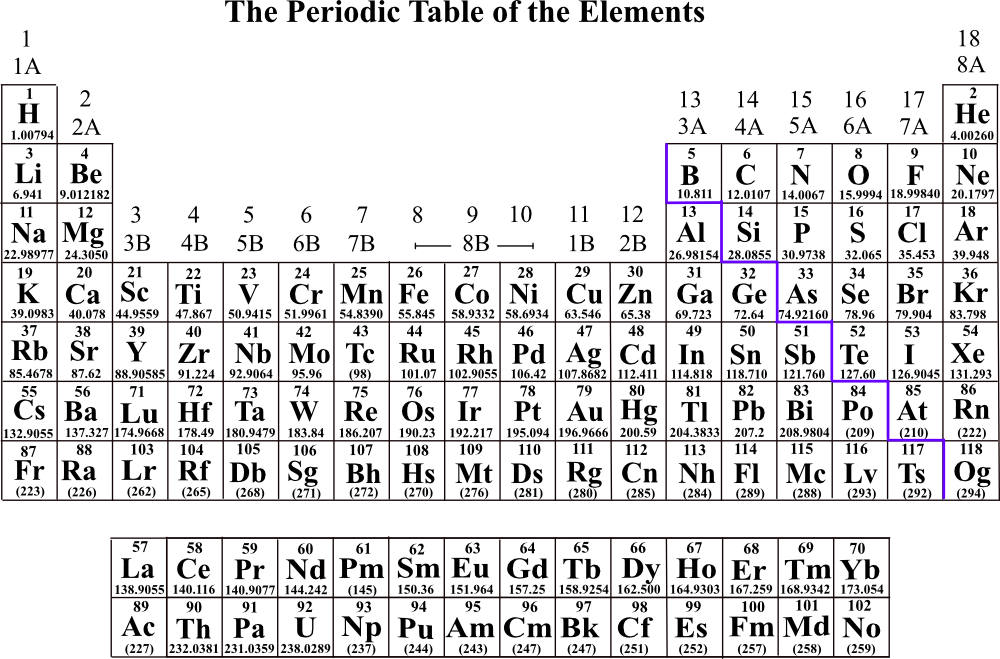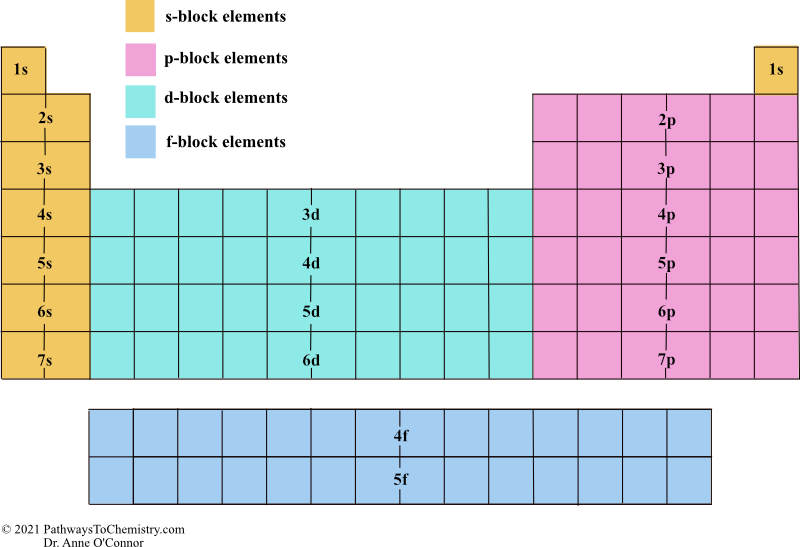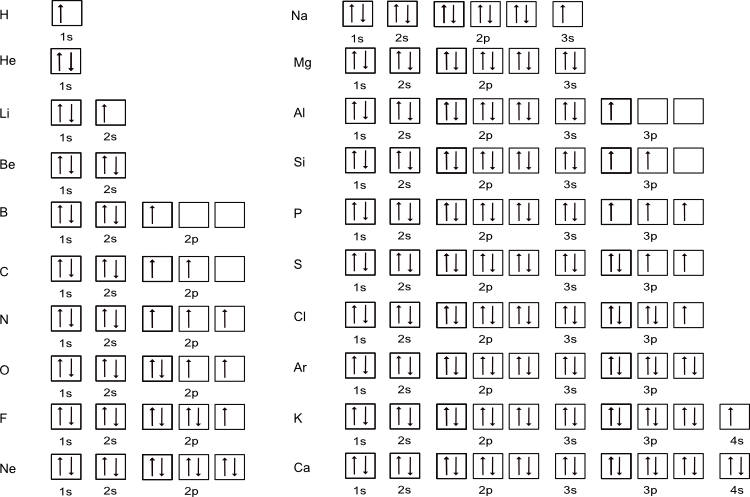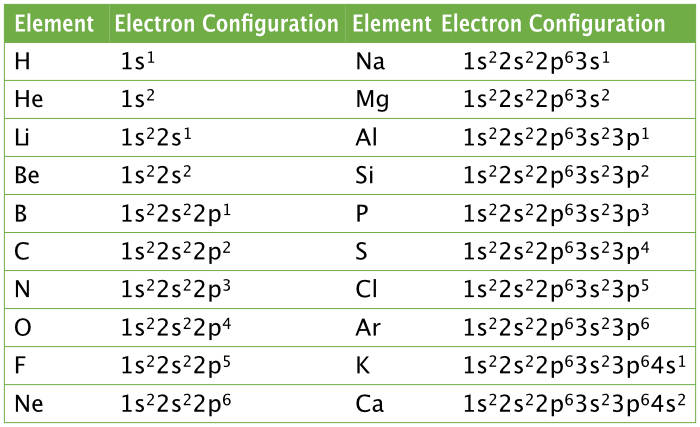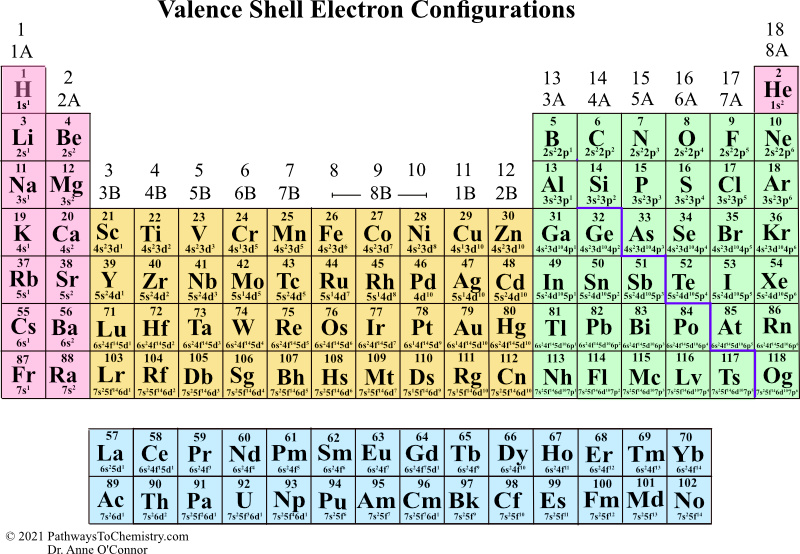To write electron configurations and draw orbital box diagrams, there are three rules that must be applied.
2. The Pauli Exclusion Principle states that each orbital may contain a maximum of 2 electrons; electrons must have opposite spins.
3. Hund’s Rule specifies that when orbitals of equal energy are available, the lowest energy electron configuration has the maximum number of unpaired electrons with parallel spins. In other words, the orbitals in a subshell must be half filled before pairing electrons.
The lowest energy orbitals must be filled first. For example the 1s orbital is filled and then we can fill the 2s orbital and go on to the 2p orbitals. The filling order follows:
1s→2s→2p→3s→3p→4s→3d→4p→5s→4d→5p→6s→4f→5d→6p→7s→5f→6d→7p
Electron configurations and orbital box diagrams can be written right from the periodic table.
The periodic table below, shows the s, p, d, and f-blocks. When reading the periodic table from left to right, one can easily write an electron configuration without memorizing the filling order. You only need to know where the blocks are located on the periodic table.
Hydrogen has 1 electron which goes into the 1s subshell. The electron configuration is 1s1. Helium has 2 electrons and both electrons go into the 1s orbital and the electron configuration is 1s2. Next we go to lithium with 3 electrons; two of the electrons go into the 1s orbital and the third electron into the 2s orbital giving an electron configuration of 1s22s1. The four electrons of Be go into the 1s and the 2s orbitals giving the electron configuration of 1s22s2. Reading the periodic table from left to right, the boron atom has 5 electrons, and the electron configuration is 1s22s22p1. The electron configuration for carbon is 1s22s22p2. An orbital box diagram can be written as well. Boxes, or horizontal lines represent the orbitals, arrows represent the electrons, and if an orbital is full, the electrons must be of opposite spin–one arrow pointing up and the other one pointing down. The orbital box diagrams are listed for the first 20 elements in the figure below.
In the figure below are the electron configurations for the first 20 elements.
Next, we write the electron configuration for Sc. When reading the periodic table from left to right we fill all the way to the 4s orbital and then fill a 3d orbital with the last electron. The electron configuration is 1s22s22p63s23p64s23d1. The electron configuration for Fe is 1s22s22p63s23p64s23d6. The electron configuration for Sn is 1s22s22p63s23p64s23d104p65s24d105p2.
Recall when we fill the 6s orbital, the next orbitals to be filled are the 4f orbitals. The electron configuration for Pb is 1s22s22p63s23p64s23d104p65s24d105p66s24f145d106p2. Note, when the 4f orbitals were filled, we then fill the 5d orbitals and the remaining electrons go into the 6p orbitals.
The outermost shell is the valence shell. The electrons in the valence shell are the valence electrons. For the main group elements, the number of valence shell electrons are equal to the group number (Groups 1A to 8A). For transition elements, the ns and the (n – 1)d electrons are the valence shell electrons. Sodium, in Group 1A, has 1 valence electron in the 3s oribital and chlorine in Group 7A has 7 valence electrons, with 2 electrons in the 3s and 5 electrons in the 3p orbitals. Iron has 8 valence electrons with 2 electrons in the 4s subshell and 6 electrons in the 3d subshell. The valence electron configurations for all of the elements are in the periodic table below.
There is a shorthand way of writing electron configurations. For example, the electron configuration for sulfur is 1s22s22p63s23p4. Up to the 2sp electrons is the noble gas configuration of neon. We can write the configuration as [Ne]3s23p4. The noble gas that comes before the sulfur atom, Ne, is placed in brackets and the rest of the configuration is written. The shorthand electron configuration for Fe is [Ar]4s23d6. The configuration for Pb can be written as [Xe]6s24f145d106p2.
Anomalous Electron Configurations
There are over 20 elements that do not follow the building up principle. For example, using the building up principle Cr would have an electron configuration of [Ar]4s23d4. Experiments show this is incorrect and the electron configuration for Cr is [Ar]4s13d5. It is more stable to move the electron from the 4s orbital to the 3d orbital and have 2 half filled subshells. The same goes for Cu. The electron configuration is [Ar]4s13d10. It is more stable to move the electron from the 4s orbital into the 3d orbital and have a completely filled d subshell. The same is seen for Mo and Ag. As we move down the periodic table we see there are more anomalous electron configurations as shown in the periodic table above.
Worksheet: Orbital Box Diagrams and Electron Configuration Part 1
Worksheet: Orbital Box Diagrams and Electron Configuration Part 2
Watch the following videos before attempting exercises
Write Electron Configuration for an Excited State
Exercises
Exercise 1. Draw an orbital box diagram for the electrons in a neutral Br atom. Assign quantum numbers to the electrons in the valence shell.
Exercise 2. Write the full electron configuration for Pd. Write the shorthand notation for Pd.
Exercise 3. Write an electron configuration for Cd.
Exercise 4. Write an electron configuration for Hg.
Exercise 5. Assign quantum numbers to the valence shell electrons in Cr.
Back to Electronic Structure of Atoms
Back to General Chemistry 1 Study Guides
Back to Home Page

